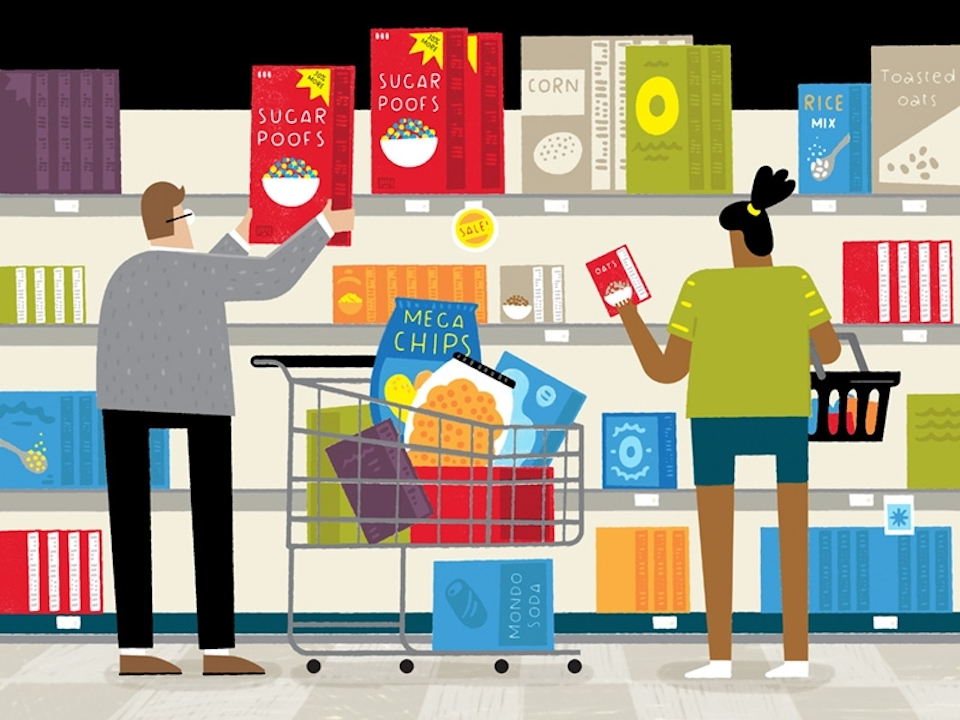Takeaways
- Star labels were introduced into supermarkets across Canada to promote shopping for healthier foods.
- Anonymized shopping data revealed the star labeling system had little long-term effect changing the food buying habits of most people.
- But the labels did influence a limited set of shoppers while the educational campaign was active to buy less junk food and more fresh produce.
Taste. Price. Convenience. Grocery shopping can be a balancing act, but in the last two decades, many companies and governments instituted front-of-box or front-of-shelf nutrition labels to help shoppers make better decisions.
But do they work?
Meh.
According to a large-scale study published by Terry health economist Eli Liebman and his co-authors, education on simplified nutrition labeling can make a difference for consumers who aren’t already reading labels. However, those committed to buying for taste or convenience are still going to stock up on pizza rolls and chips, no matter what the label says.
Liebman, an assistant professor in the Department of Economics, along with NYU marketing professor Bryan Bollinger and Canadian public health researchers David Hammond, Erin Hobin and Jocelyn Sacco, published their paper “Educational Campaigns for Product Labels: Evidence from On-Shelf Nutritional Labeling” in the February issue of the Journal of Marketing Research.
“The labels aren’t a panacea,” Liebman says. “It’s hard to change consumer behavior. They may make an impact, but for the most part, we go and buy the things we are used to buying.
“It helps, but there’s more that needs to be done if we want to help people make healthier choices.”
Liebman and Bollinger teamed up with Canadian researchers to test the efficacy of health labeling and education programs. They found a natural experiment when a large Canadian supermarket chain launched a nationwide campaign to promote Guiding Stars.
Guiding Stars, used in the U.S. and Canada, is a third-party auditing group that uses an algorithm to analyze the nutrition of thousands of products and rates them 0 to 3 stars, with 3 stars marking the healthiest choices. The stars are displayed on supermarket shelves with the product’s price.
The star labels had been tested in limited markets in 2012 and were introduced into supermarkets across Canada in late 2014 and early 2015. This large rollout was aided by an educational campaign that included TV ads and store signage.
Liebman’s study analyzed buying patterns before and after the campaign by using data from shoppers’ loyalty cards. The researchers were able to track changes in overall patterns as well as changes within households.
The size and anonymity of the data set allowed researchers to find small shifts in shopping habits and avoid the bias that can sometimes creep into self-reported nutrition studies.
“People may say they’re interested in using the labels to make healthier purchases,” Liebman says. “But they may not be that interested in using them when a researcher isn’t watching.”
Using the customers’ anonymized loyalty card data also allowed for a huge sample size, which is what drew Liebman to the project in the first place. He typically uses large-data econometric techniques to find insight into health-related questions.
“They’re giving us terabytes of data from every purchase from dozens of stores for multiple years. So it’s a lot to work with,” he says. “We were able to find subtle impacts that would be harder to find in a smaller-scale 200-person panel. It takes a lot more data to parse some of that out.”
They compared customers’ shopping habits in the same stores from one year to the next. The data revealed the labeling scheme had little long-term effect on households already buying healthy foods and little effect on die-hard junk food fans.
However, it did help some shoppers make better choices while the campaign was active and improved some habits afterward. For instance, comparing household shopping trends allowed Liebman’s team to pinpoint a group of shoppers who bought more produce during and after the educational campaign
People who paid attention to the Guiding Star labels, it seems, weren’t swapping unhealthy junk foods for healthier junk food, they were buying less junk food and more healthy food. So, there was a positive effect, but not in the way policymakers might expect, he says.
“People who want to eat healthily and it’s really important to them — those people don’t need a label or simplified information to know that a food is healthy,” Liebman says. “Then there are people who probably don’t care, and those people are going to buy less healthy food. If they want to buy ice cream, they’re going to go ahead and buy ice cream whether it’s got a healthy food label or not.
“Our study suggests there’s a limited set of people who are using this information and for whom this information is changing the way they think about food.”

